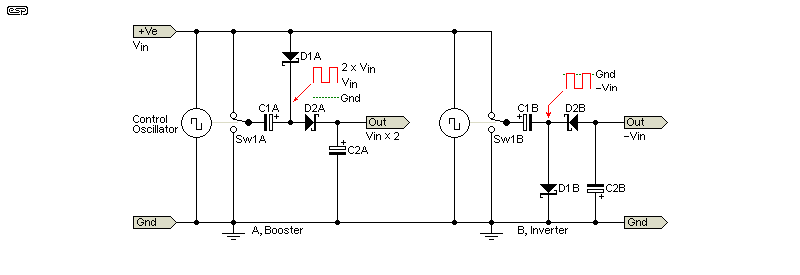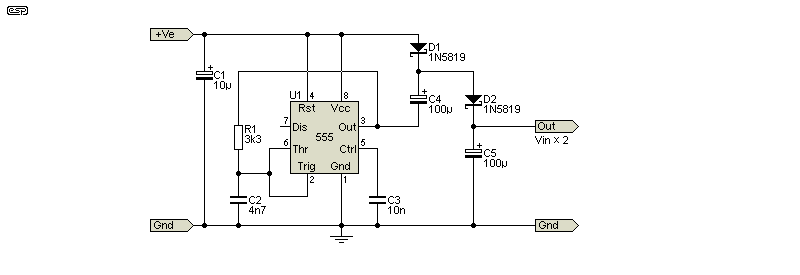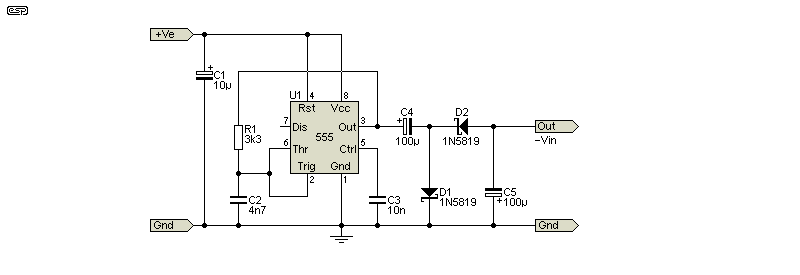

|
| Elliott Sound Products | Project 248 |
These ultra-simple projects are intended to provide two simple functions without the need for transformers or 'esoteric' parts. The first is a simple charge-pump voltage booster, that will raise your supply voltage by a factor of two - at least in theory. Reality is different, because there are losses in the 555 timer and in the Schottky diodes. The latter can be minimised by using higher current diodes, but there's still a small loss.
The second circuit generates a negative voltage, often useful or essential for a project where only a single supply is available. The negative voltage is a little lower than the positive supply, again because of losses in the timer IC and Schottky diodes. These losses are inevitable, and while it is possible to reduce them, it adds complexity to what is meant to be a simple circuit. Dedicated ICs can have surprisingly complex internal circuits, and it would not be sensible to try to reproduce these in discrete circuitry.
Neither circuit is designed for high current, and this type of circuit is most often used when you need a higher (or negative) voltage, but only at a few milliamps. Mostly, this type of circuit (at least when using a 555 timer IC) is used where you only need up to 20mA. You can get more, but the voltage will sag rather badly above 30mA or so. In many cases this won't matter. If your expected current is very low (< 5mA) you may be able to use the 7555 - the CMOS version of the 555 timer. It can operate faster (up to 500kHz), but can't supply much current, and that is its main limitation. Mostly you'll use a 'standard' 555 timer which can supply more current (source and sink).
The circuits are shown with an assumed 12V supply, but they will work with 9V (with additional losses) or up to 15V, the maximum recommended for the 555 timer IC. Operation at 5V is theoretically possible, but the performance will be very poor. Both can be used to 'stack' a power supply, so you could get a +47V supply 'stacked' on top of a +35V supply. The same is possible for the negative voltage generator, but great care is needed to ensure that the output pin of the 555 timer can never be forced below zero (that can cause the IC to latch, and it requires a power off-on sequence to re-start).
For a complete discussion on the 555 timer and its uses, see The 555 Timer article. This covers (almost) everything you're likely to need to know about this versatile IC.
The principle of a charge-pump is pretty straightforward. A switching system connects the output alternately between the positive supply and ground, ideally with no voltage drops due to transistors or series resistance. Since ICs all use transistor switches, there are inevitable losses. Dedicated charge-pump ICs minimise these losses, but they can't be eliminated. The operation of a booster is quite different from that for a voltage inverter, but they tend to be lumped together in most descriptions. Despite initial appearances, the voltage across C1 (either circuit) barely changes once the initial set-up conditions are established. There is ripple current though, and it's roughly twice the output current.

Figure 1 - Boost (A) And Invert (B) Circuit Operating Principles
The 'ideal' switches are toggled by the control oscillator, and when one contact is open the other is closed. We'll look at the boost circuit first. When the switch is closed to ground, C1A charges via D1A from the supply to ground. When the switch changes state, the charge on C1A boosts the positive end to twice the input voltage (2 × Vin). This doubled voltage is transferred to C2A via D2A. If there were no voltage drops across the diodes, the output voltage would be exactly double the input (DC) voltage. The output cap (C2A) must have a voltage rating to suit the maximum output. It's also possible to connect the negative of C2A to +Ve - it's rarely seen, but works perfectly well, and means the cap's voltage rating doesn't need to be 2×+Ve.
The negative voltage generator circuit works very differently. The connection of C1B and D1B forms a simple voltage clamp, with the input voltage varying from zero to +Ve. Back in the days of analogue television, this circuit was commonly known as a 'DC restorer'. When the switch is connected to +Ve, C1B charges via D1B. When the switch connects to ground, the positive of C1B is grounded, so the negative terminal has -Ve on it, which is coupled to C2B via D2B so C2B now also has -Ve across it. This is the negative supply. The rectifier is half-wave. C2B is charged at the switching frequency.
The output ripple is determined by the switching speed, the value of C1 and C2, and the load current. In general, C1 and C2 are usually made equal, but it's often quite aright if C1 is a lower value. For example, C1 might be 33μF, while C2 could be 100μF. If they aren't equal the output voltage is reduced a little, and ripple is increased. 100μF is a good 'general purpose' value, but if the required current is less than 10mA, the caps can be reduced. I don't recommend anything less than 33μF though, because the 555 timer doesn't like high frequencies. Operation at (or around) 30kHz is a reasonable compromise.
With the 'ideal' circuits shown above, the output ripple is about 5.4mV p-p for the doubler (100μF, 30kHz) and 4.7mV p-p for the inverter (same values). This is with an output current of (very roughly) 10mA for both. If the capacitance is increased by a factor of three, the ripple is reduced by the same amount. Likewise, if the oscillator frequency is halved, the ripple is doubled.
Neither circuit is designed for high current, and in general it should be no more than 10mA or so. The 555 timer is configured as a 'minimal component count' oscillator, saving a resistor compared to the 'conventional' astable (no stable state) oscillator. The frequency is nominally about 32kHz to ensure that it's out of hearing range. You can get around 20mA if you're willing to lose 4V (12V in, -12V out or 12V in, 24V out). The actual outputs will be around -8V or +20V (inverting, boosting respectively).

Figure 2 - Boost Circuit - 12V In, 24V Out (Nominal)
I've kept the circuit as simple as possible. Using Schottky diodes is a must if you're struggling for the last bit of voltage, but otherwise you can use 1N4148 diodes. These circuits are deigned for low current, and while a higher current version is possible, it becomes irksome. There are dedicated ICs that perform the same task with fewer external parts, but some are surprisingly expensive for something that's really quite pedestrian. The TC7660(S) (negative voltage converter) is low cost (under AU$2.00 each) but they are dedicated to negative conversion mode. They also have a limited supply voltage (10V for the 7660, 12V for the 7660S). Like most of these ICs, they are not designed for high current. Many are in SMD packages, with some using the least user-friendly packages possible (leadless chip carriers - LLCC) which is most unhelpful for DIY projects.

Figure 3 - Inverting Circuit - 12V In, -12V Out (Nominal)
The inverting circuit (if 100% efficient) would provide a -12V supply. The limitation is the 555 itself, as it can't source or sink enough current to get the full 0-12V output swing under load. The maximum is around 10V, with a minimum of 750mV (at an output current of +26mA and -36mA). The diodes also reduce the available voltage, because even Schottky diodes have a forward voltage. Those shown are recommended as they are designed for relatively high current (1A), although they are 40V types and have a higher forward voltage than 1N5157 (20V) and 1N5158 (30V).
The benefits of staying with one of the most common ICs ever produced is that you can get them almost anywhere. You could get them 20 years ago (actually much longer), and in 20 years time you'll still be able to get them. That will not be the case with many of the dedicated devices, and some could become obsolete tomorrow afternoon. There is no doubt that dedicated ICs can drive higher current, but even just 20mA can power up to two NE5532 dual opamps, many more for lower current types.
The voltage booster is a 'true' charge pump. When the output of the 555 is low, C4 charges from the supply via D1. When the output goes high, the positive end of C4 is forced high (to +24V in a perfect world), and the charge is transferred to C5 via D2. This is a very common arrangement, and it's used in almost every high-side MOSFET gate driver ever produced. In those circuits, C4 is referred to as a bootstrap capacitor. The negative converter is a simple half-wave negative voltage doubler. Why is it a doubler? The RMS voltage feeding C4 is half the supply voltage (so 6V with a 50:50 on/off ratio), and to get -12V you use a voltage doubler.
It has become common to refer to this class of circuit as a charge-pump, regardless of its real modus operandi. There's no need to use the alternative names, as even though they are (IMO) more descriptive, the term 'charge-pump' is so common that it would not be sensible to try to change it. Likewise, it would be unwise to try to use either circuit for high current, as small switchmode modules can be obtained for very little cost if you happen to need more than 20mA, or if you need reasonable voltage regulation.
The two circuits are shown with 100μF caps, but these can be increased. The output cap (C5) is the most critical, as that determines the ripple on the output voltage. Using 100μF, you can expect fairly low ripple with a 10mA load. More than around 220μF is unlikely to provide much benefit. Expect less than 1.5mV (3mV for the inverting circuit) with 100μF. A larger cap also increases the average output voltage for a given load, which can be useful.
The 'minimum component count' version of the 555 astable multivibrator will change frequency slightly as the load is changed. Mostly this doesn't matter at all, and that's why I used it. The frequency is given by the formula ...
f = 0.72 / RC Where R and C are the timing components
This isn't exact, and as noted it will change with the load. Ideally, the 'high' and 'low' periods would be identical, but as you can likely appreciate, this changes the operation very little. Simple circuits are (by definition) simple, and there's no point trying to make them perfect. Nothing built with a 555 timer is perfect - it's a general-purpose, utilitarian device. Yes, you can get fairly good accuracy from a 555, but mostly we really don't care very much. If we did want high accuracy, we'd use something else.
There is an alternative to a charge-pump, and there's every chance it will actually cost less than a 555 timer plus ancillary components. The one pictured below came from eBay, as I recall it was less than AU$4.00. They're available in a range of input and output voltages, so you can invert or boost almost any voltage you like. The one shown is rated for 1W, so the 12V version can provide 83mA. They all manage to use the same pinouts, with Pin 1 as input ground, Pin 2 is input DC, Pin 3 is output negative and Pin 4 is output positive.
Because they are isolated, the secondary can be at any voltage within the stated range in the datasheet. While most are tested to 1kV, the voltage differential should normally be within the SELV (safety extra-low voltage) range, which is 42.4V peak (30V AC) or 60V DC, although the definition varies from country to country. I wouldn't exceed ~150V DC across the isolation barrier. Texas Instruments makes the UCC12050DVE, which is a single IC that includes an internal transformer (a similar IC is the UCC12051-Q1). It's limited to a maximum output of about 5V at 100mA. It requires a few external parts, but it's designed for 1.2kV isolation (working value) and costs around AU$12.00 one-off. Few hobbyist applications will require this level of isolation, but it's apparent that the need exists for these devices (predictably, SMD only).

Figure 4 - Cheap (Chinese) 12V-12V DC-DC Converter (K-Cut B1212S-1W)
Similar modules are available from all major suppliers, with many costing less than AU$5.00 each. If you need to do something more adventurous you can experiment, but these small (12 x 10 x 6mm) isolated DC-DC converters are often a far better proposition, and take up far less PCB real estate than a discrete solution. Being isolated means you have galvanic isolation (not for voltages over 150V or so though), and the 1W versions are capable of 83mA (12V). They are made for step-up, step down or direct conversion, and voltages of 5, 12, 15 and 24V are common. Manufacturers include AimTec, CUI, Mornsun, Murata, Recom and Traco Power, plus innumerable Asian versions (often without a name printed on the case).
If you buy these from eBay, be careful. Some sellers want AU$15.00 or more for a module that should be less than AU$3.00, and in some cases the cost is greater than from the major suppliers. From these (e.g. Element14, Digikey, Mouser, RS etc.) you can expect to pay from AU$5.00 up to AU$15.00 or so, with no apparent difference between the modules regardless of the price. I find this puzzling, but it is what it is. The range of these just keeps getting better, and I expect that they'll be around for a long time, as they are so convenient. One down-side is noise, as they are not particularly quiet. A simple RC (resistor-capacitor) output filter will get rid of most of the noise though.
Note that some datasheets state that an input capacitor is required (between +Ve and Ground) to minimise noise. Some also include a maximum capacitance that can be used in parallel with the output. Using more than the recommended maximum may cause startup problems.
These circuits are shown in their basic form only. While there's no doubt that a 555 based circuit will be perfectly alright in many cases, the little modules as shown in Fig 4 are a very hard act to follow. They are so simple to use that anything else doesn't really make sense.
I've suggested these modules in a number of other projects and I've used them in a number of designs. However, sometimes you just need to make something with what you have to hand, and 555 timer charge-pumps are ideal for low currents and where the voltage regulation just doesn't matter. Perhaps unexpectedly, this includes opamps that need a dual supply where only one supply is available. Most opamps don't care if the supply voltages aren't equal, and the only downside is that clipping will be asymmetrical. If the signal doesn't clip, there's no issue at all, other than the limited supply current.
Sometimes you just need a circuit that works, requires no parts you don't have in your component stash, and is easy (and cheap) to put together on a small piece of Veroboard. These circuits have been around for a long time, and while the 555 is not ideal, it does work and you can get them anywhere. A PCB for these charge-pumps will not be forthcoming, for the simple reason that there are so few parts it would be silly.
There are no references (apart from mentioned component datasheets) as the techniques are well-known and have been around for a very long time.
Datasheets for the isolated DC-DC converters are available from supplier and manufacturer websites.
 Main Index Main Index
 Projects Index Projects Index
|